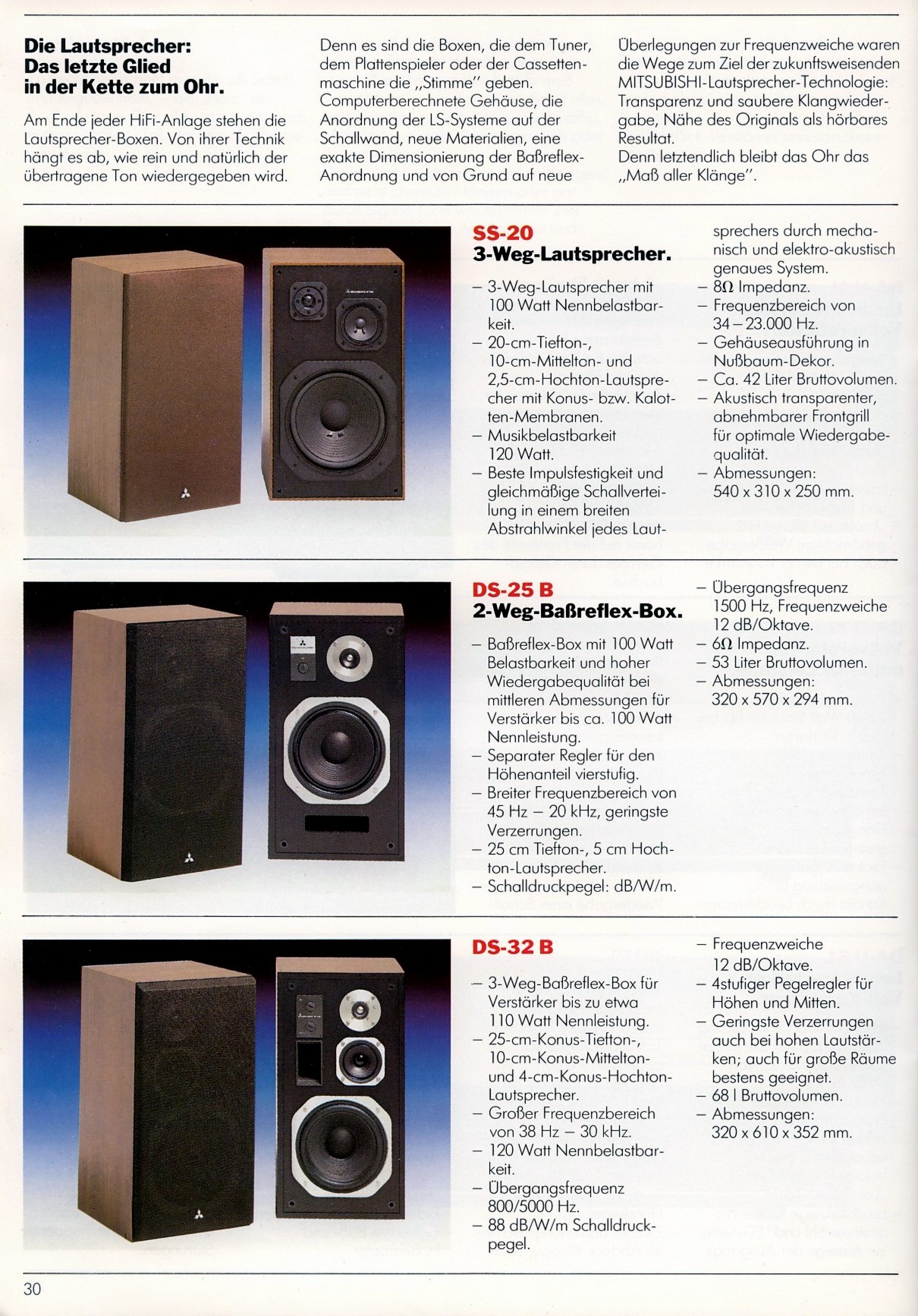Difference between revisions of "Mitsubishi SS-20"
(→Technische Daten) |
|||
| (3 intermediate revisions by 2 users not shown) | |||
| Line 1: | Line 1: | ||
| − | == | + | __NOTOC__ |
| − | * | + | == Data == |
| − | * | + | {{navigation}} |
| − | * | + | '''General''' |
| − | * | + | * Manufacturer: [[Mitsubishi]] |
| − | * | + | * Model: SS-20 |
| − | * | + | * Type: Loudspeaker |
| − | * | + | * Years of manufacture: 1982 - 1984 |
| − | * | + | * Made in: Germany |
| + | * Color: Walnut | ||
| + | * Dimensions (WxHxD): 310 x 540 x 250 mm | ||
| + | * Weight: 10,5 kg | ||
| + | * Original price approx.: 350 DM / piece | ||
| − | |||
| − | + | '''Technical Data''' | |
| − | + | * Type: 3-way closed compact speaker | |
| − | + | * Chassis: | |
| − | + | ** Low frequency: 200 mm cone | |
| + | Midrange: 100 mm cone | ||
| + | Tweeter: 25 mm dome | ||
| + | Power handling (nominal/music): 90 W / 120 Watt | ||
| + | Efficiency: | ||
| + | * Frequency response: 34 - 23,000 Hz. | ||
| + | * Transient response: | ||
| + | * Impedance: 8 Ohm | ||
| − | |||
| − | |||
| − | |||
| − | |||
| − | |||
| − | |||
| − | |||
| − | |||
| − | + | '''Special Features''' | |
| − | + | * Front cover removable | |
| − | |||
| − | |||
| − | |||
| − | [[ | + | == Remarks == |
| + | * General note on 8 Ohm impedance: Some loudspeakers work internally with 4 Ohm and achieve the 8 Ohm at the connection by an additional 4 Ohm wire resistor (usually with square ceramic coating) at the connection. | ||
| + | * I don't know if this is also the case with this model. If you have a 4 Ohm capable amplifier, you can convert such speakers: | ||
| + | ** Unscrew the bass speaker, bridge the series resistor and change the impedance on the nameplate to 4 ohms (changing the nameplate is important because a 4 ohm speaker can overload an amplifier with 8 ohms minimum impedance, e.g. Mitsubishi DA-R45P and DA-R47P). | ||
| + | ** The advantage is that an amplifier will perform better at 4 ohms than at 8 ohms. | ||
| + | The disadvantage is, as already mentioned, that the speaker can no longer be connected to all amplifiers. | ||
| + | |||
| + | |||
| + | * Other models of the same series: | ||
| + | * [[Mitsubishi SS-7 G]] | ||
| + | * [[Mitsubishi SS-20]] | ||
| + | * [[Mitsubishi DS-25 B]] | ||
| + | * [[Mitsubishi DS-32 B]] | ||
| + | * [[Mitsubishi DS-501]] | ||
| + | * [[Mitsubishi MS-40]] | ||
| + | |||
| + | |||
| + | == Pictures == | ||
| + | * Extract from brochure: Mitsubishi SS-20, DS-25 B, DS-32 B | ||
| + | [[File:Mitsubishi SS-20-Prospekt-1.jpg]] | ||
| + | |||
| + | |||
| + | == Reports == | ||
| + | |||
| + | |||
| + | == Links == | ||
| + | |||
| + | |||
| + | [[Category:Loudspeaker]] | ||
Latest revision as of 03:54, 10 July 2019
Data
General
- Manufacturer: Mitsubishi
- Model: SS-20
- Type: Loudspeaker
- Years of manufacture: 1982 - 1984
- Made in: Germany
- Color: Walnut
- Dimensions (WxHxD): 310 x 540 x 250 mm
- Weight: 10,5 kg
- Original price approx.: 350 DM / piece
Technical Data
- Type: 3-way closed compact speaker
- Chassis:
- Low frequency: 200 mm cone
Midrange: 100 mm cone Tweeter: 25 mm dome Power handling (nominal/music): 90 W / 120 Watt Efficiency:
- Frequency response: 34 - 23,000 Hz.
- Transient response:
- Impedance: 8 Ohm
Special Features
- Front cover removable
Remarks
- General note on 8 Ohm impedance: Some loudspeakers work internally with 4 Ohm and achieve the 8 Ohm at the connection by an additional 4 Ohm wire resistor (usually with square ceramic coating) at the connection.
- I don't know if this is also the case with this model. If you have a 4 Ohm capable amplifier, you can convert such speakers:
- Unscrew the bass speaker, bridge the series resistor and change the impedance on the nameplate to 4 ohms (changing the nameplate is important because a 4 ohm speaker can overload an amplifier with 8 ohms minimum impedance, e.g. Mitsubishi DA-R45P and DA-R47P).
- The advantage is that an amplifier will perform better at 4 ohms than at 8 ohms.
The disadvantage is, as already mentioned, that the speaker can no longer be connected to all amplifiers.
- Other models of the same series:
- Mitsubishi SS-7 G
- Mitsubishi SS-20
- Mitsubishi DS-25 B
- Mitsubishi DS-32 B
- Mitsubishi DS-501
- Mitsubishi MS-40
Pictures
- Extract from brochure: Mitsubishi SS-20, DS-25 B, DS-32 B
